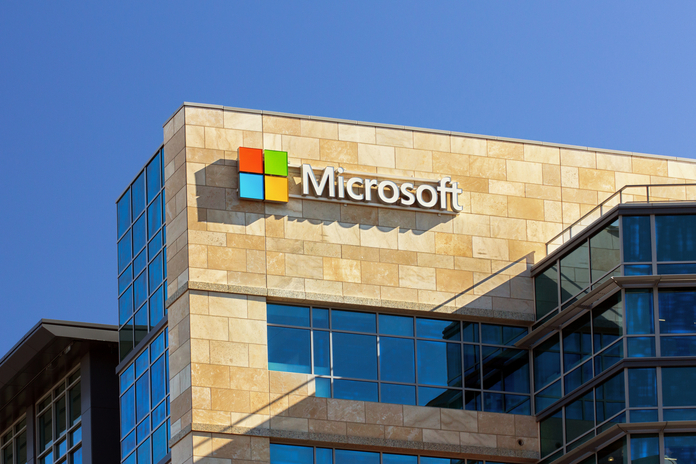Microsoft (NASDAQ:MSFT) may have single-handedly ignited a rally in tech equities by demonstrating that the expansion of the digital transformation will outlast inflation and the Russia-Ukraine conflict. In addition to maintaining its significant margins and secular growth, MSFT rewards shareholders with rising dividends and share repurchases.
Although the stock is not now as inexpensive as its tech counterparts, this company has established itself as a sort of forerunner in the industry, and its value reflects that. The stock is still a buy, and I think operating leverage will help the business continue to expand its earnings by double digits for many years to come.
Price of MSFT
The stock has since declined by 20% after peaking at just under $350 a share at the beginning of the year.
One may rationally presume that the rest of the technology sector must be falling even more when a stock like MSFT declines by that much (and in this case, they would be right). The business’s ongoing success demonstrates that MSFT is a dependable cash flow machine.
What Profits Did Microsoft Expect?
On July 26, MSFT was due to release its quarterly financial results. $52.36 billion in revenues and earnings per share of $2.17 were anticipated.
Has Microsoft outperformed earnings?
Although the corporation almost missed on both counts, the earnings were hurt by foreign exchange headwinds. After accounting for constant currency, MSFT’s results aligned with the projections it had previously made.
Critical Metrics for MSFT Stock
Microsoft saw a 12% increase in sales during the quarter (or 16% in constant currency) and a 3% increase in earnings per share.
Due to its productivity products like Microsoft Word, MSFT may be well known to investors. These well-known products kept expanding at a double-digit rate, with LinkedIn leading the pack with a revenue increase of 26%.
On the conference call, management remarked that LinkedIn’s success was particularly notable because, like other online advertising businesses, it had challenges in the sluggish online advertising industry.
In my opinion, cloud computing is swiftly evolving into one of Microsoft’s more significant news stories. Azure and other cloud services saw excellent quarterly growth of 40%, contributing to a 22% increase in server goods and cloud services overall.
Although MSFT does not explicitly break out Azure financials, based on the figures that have been made public, I project that the quarter’s revenues for Azure and other cloud services were roughly $9 billion.
The “more personal computing” section of MSFT did experience a slowdown, which is understandable given the challenging pandemic comparables.
Microsoft distributed $12.4 billion in the quarter to shareholders in the form of $4.6 billion in dividends and $7.8 billion in share repurchases.
The corporation had $104.7 billion in cash at the end of the quarter compared to $49.7 billion in debt; this kind of business I anticipate will manage net leverage over the long term.
Observations Following Earnings
Those outcomes weren’t extraordinary, but they were adequate. The advice was “heard around the world” instead. According to MSFT’s guidance, “continued momentum in our commercial business and a focus on share gains across our portfolio” will lead to “double-digit revenue and operating income growth.”
That kind of remark is commonplace in everyday life. But considering the severe stock price swings in the tech industry, that kind of direction eased concerns about the end of technology. Given the similarities between the current stock price movements and the tech stock crash of 2000–2001, possibly some investors were anticipating tech earnings to underperform significantly. MSFT has disproved their claims.
Is Microsoft a Long-Term Smart Investment?
Long term, I anticipate Microsoft to keep enabling digital transformation within businesses while also rapidly expanding its cloud operations. Over the next ten years, double-digit earnings growth is predicted to continue.
Considering how little operating leverage there is compared to revenue growth, I think such predictions are conservative.
MSFT is anticipated to create net margins of 40.7% in 2032, slightly higher than the predicted net margin of 34.6% for this year.
Should I buy, sell, or hold MSFT stock?
The stock may not appear cheap to a casual observer, given its 27x forward earnings multiple. And in fact, that pricing does not convey the same level of gloom as is seen elsewhere in the technology sector, where several tech companies have fallen by 80% or more. But unlike most tech firms, MSFT has been able to combine strong GAAP profitability with secular growth, all while rewarding investors with dividends and share repurchases.
As long as MSFT continues to produce double-digit top and bottom-line growth, I could see its valuation rising to 40 times earnings over time. That represents a 50% potential upside, but I should point out that that upside may be more likely spread over several years. Coupled with double-digit growth, this should produce returns that outperform the market.
Here, there are primarily two hazards. First, the law of large numbers says that growth rates should eventually slow down given that MSFT is already a $2 trillion firm. This can result in a decline in valuation, which might reduce shareholder returns.
There are numerous instances of slow-growth corporations trading at high multiples; nevertheless, there is no assurance that MSFT will develop a similar shareholder base. Operating leverage, in my opinion, should support MSFT’s more robust bottom-line growth for at least a few years.
Because of its potential to outperform the market, I still rate Microsoft as a buy. Still, I want to underline that there are other IT companies where you can get a better deal.
Featured Image: Megapixl © Wolterk















